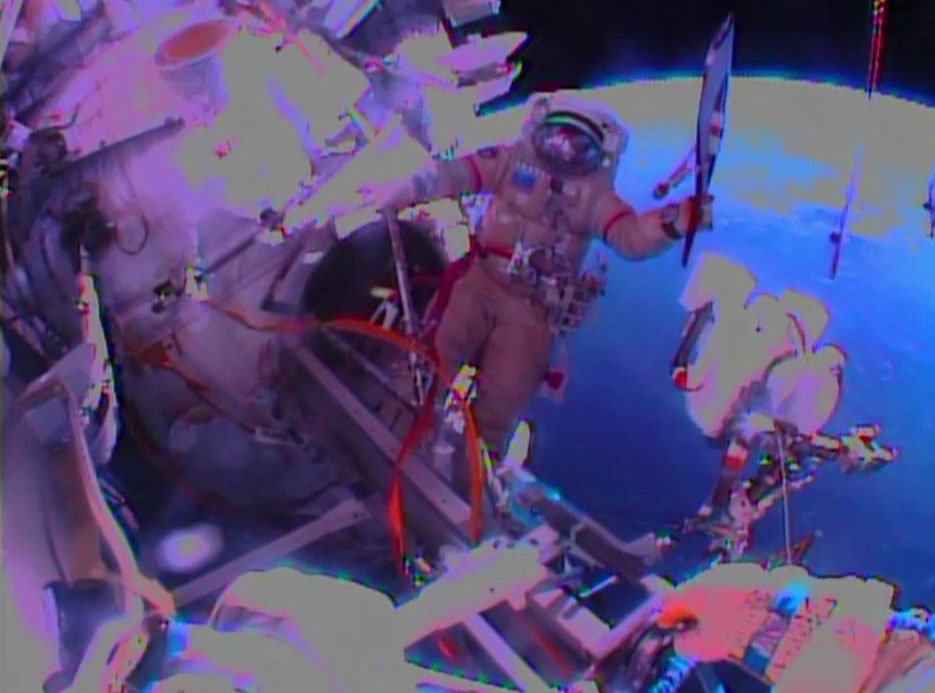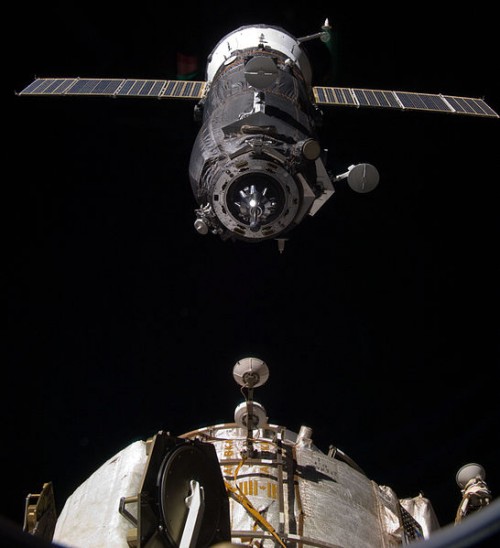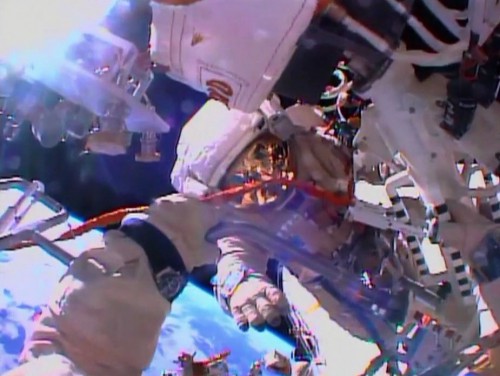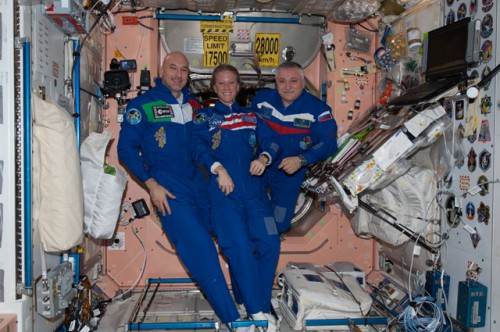
Expedition 37 crewmen Oleg Kotov and Sergei Ryazansky ventured outside the International Space Station (ISS) earlier today (Saturday) on a near-six-hour spacewalk, the highlight of which was to display the Olympic torch as part of the 2014 Sochi Winter Games relay. Clad in Russian-built Orlan-MK (“Sea Eagle”) space suits, the two cosmonauts—with Kotov on his fourth career EVA and Ryazansky on his first—officially departed the airlock hatch of the Pirs module at 9:34 a.m. EST and within a few minutes began transmitting spectacular pictures of the red-and-chrome torch, then set to work on their other tasks. Despite their sterling efforts, and some astonishing imagery of themselves and the cloud-bedecked Earth, their other tasks met with frustration and the EVA ended after five hours and 50 minutes.
As described by NASA last week, the symbolic Olympic torch relay was just one small part of this lengthy spacewalk, which also featured the preparation of the Urthecast pointing platform for the installation of a high-definition Earth-observation camera in December, the relocation of a foot restraint, the removal of a microwave radiometry experiment, and the photo-documentation of multi-layer insulation on the Russian Segment. For the purposes of identification, Kotov’s Orlan-MK suit was emblazoned with red stripes, whilst that of Ryazansky carried blue stripes.
According to Spaceflight101, preparations for EVA-36—the 36th spacewalk to be conducted from the Russian Segment—got underway about two weeks ago with suit fit checks, battery charging and communications, and other systems tests. Kotov and Ryazansky also installed pressurization tanks inside the 16-foot-long (4.9-meter) Pirs module and conducted a lengthy suited rehearsal of their preparations last week. Earlier today, assisted by Expedition 37 crewmate Mikhail Tyurin, the men began donning their suits at about 7:50 a.m. EST, and both they and the Olympic torch were in position inside Pirs shortly thereafter. Following leak checks, purging of their suits and mandatory “pre-breathing,” the cosmonauts transferred their Orlan-MKs to internal battery power at about 9:30 a.m., and the EVA officially got underway a few minutes later.

Built by the Zvezda NPP design bureau, the Orlan-MK suit weighs 265 pounds (120 kg) and operates at 5.8 psi. It was first tested by Expedition 19 crewmen Gennadi Padalka and Mike Barratt on a spacewalk in June 2009. In addition to a seven-hour life-support capacity, it carries equipment within its backpack to process data from the suit’s systems and can issue warnings in the event of a malfunction. A contingency plan is then displayed on a small screen affixed to the right side of the Orlan-MK’s torso. This is designed to circumvent the need for spacewalkers to memorize their reactions in an emergency situation. As a space suit “family,” five generations of Orlans can trace their heritage back to the 1970s and were employed by cosmonauts aboard the Salyut 6 and 7 space stations, aboard Mir in the 1980s and 1990s, and have served aboard the ISS since 2001.
For today’s EVA, the opening of the outer airlock hatch was followed by the installation of a protective ring to guard its external seal against damage. As planned, Ryazansky was first to leave the module and quickly set to work configuring safety tethers and establishing himself on Pirs’ EVA ladder. A few minutes later, Kotov emerged from the airlock, brandishing the Olympic torch. The cosmonauts fitted a commercial GoPro camera to capture images of the symbolic activity, and by 11:30 a.m. EST the torch operation was complete. Kotov stowed the GoPro box and the torch inside the Pirs airlock and brought out a Crew Lock Bag, containing tools for the other tasks on the spacewalk. Ryazansky translated to the interface with the station’s Zvezda service module, where he retrieved the “Yakor” (“Anchor”) foot restraint and returned it to the EVA ladder outside Pirs.
The two cosmonauts then joined forces to move the Yakor, together with an “ingress aid” and the Crew Lock Bag, to one of Zvezda’s universal work platforms, where the Biaxial Pointing Platform was mounted on Russian EVA-35 last August. The Platform will be used to point the high-resolution Urthecast camera, which is slated to be installed by Kotov and Mikhail Tyurin during EVA-37 on 23 December. This Canadian-led system is part of an international effort to fly publicly accessible cameras aboard the ISS, enabling users to directly view Earth imagery from a pair of medium- and high-resolution instruments. With difficulty, the cosmonauts removed three bracketing bolts, but were forced to use a knife to cut away some obstructing multi-layer insulation and a magnet to capture the final stubborn bolt.
Kotov and Ryazansky also encountered problems when trying to properly orient the Yakor foot restraint, ahead of installation. This restraint will be used by future spacewalkers to install scientific instruments onto the Biaxial Pointing Platform. After struggling for some time, it was finally decided by Mission Control at 1:30 p.m. EST to bring the foot restraint back inside the ISS for troubleshooting. By now, EVA-36 was four hours old and the cosmonauts’ next task was to remove the RK-21-8 microwave radiometry experiment, installed back in February 2011 by Expedition 26 cosmonauts Dmitri Kondratyev and Oleg Skripochka. The experiment measured the radiance temperature of land and ocean surfaces, with a specific focus upon soil humidity, vegetation biomass, and sea salinity on a regional and global scale.

Positioning themselves on opposite sides of the RK-21-8 experiment, Kotov and Ryazansky set to work opening connector patch panels and uncoupling the connectors. After rerouting and securing the cables, they set to work folding the four panels of the RK-21-8 antenna, concertina-like, into its original stowed configuration. Unfortunately, the panels appeared somewhat stubborn and would move only slightly. After several fruitless attempts to close them, the disappointed cosmonauts were told at 2:30 p.m. EST to leave the antenna deployed and begin wrapping up their EVA. They cleaned up their work site and headed back to the safety of the Pirs airlock. The RK-21-8 experiment will be stowed and removed on a future spacewalk to make room for upcoming scientific payloads. Concluding Russian EVA-36 at 3:24 p.m. EST—after five hours and 50 minutes—Kotov and Ryazansky’s excursion is the eight spacewalk of 2013 and the 174th to be dedicated to building and maintaining the outpost since its construction began in late 1998.
Today’s EVA posed something of a headache for the other members of Expedition 37, which currently comprises no fewer than nine astronauts and cosmonauts, following Thursday morning’s arrival of Soyuz TMA-11M. Due to the fact that parts of the Russian Segment were depressurized and rendered inaccessible during the spacewalk, NASA astronaut Mike Hopkins—who flew to the station alongside Kotov and Ryazansky on 25 September—was confined to the Poisk module and Soyuz TMA-10M, whilst Fyodor Yurchikhin, Karen Nyberg, and Luca Parmitano were restricted to their Soyuz TMA-09M vehicle at the aft end of Zvezda, and Mikhail Tyurin, Rick Mastracchio, and Koichi Wakata had the free run of the station’s U.S. Segment, together with the Zarya and Rassvet modules and their own Soyuz TMA-11M craft.

It is ironic that the main tasks of today’s EVA should have met with such frustration and disappointment, for the world’s media has centered its attention almost exclusively on the display of the Olympic torch. Ceremonially lit in Olympia, Greece, on 29 September, its Russian relay began on 7 October in Moscow’s Red Square and will travel through 2,900 towns and villages, ahead of its arrival at the Black Sea coastal city of Sochi for the official start of the Games on 7 February 2014. Kotov’s daughter and Ryazansky’s wife are participating in the Olympic relay on the ground. For its “space” leg of its relay, the torch looks similar to those used on the ground, albeit with several modifications. “An open flame in space would be dangerous,” explained Spaceflight101, adding that “the torch will feature a simulated flame. Another modification made on the flight model and its backup that is already aboard the station is the addition of a safety tether.”
In the wake of today’s successful journey of the torch into outer space, Kotov and Ryazansky brought the symbol of the Games back inside the ISS, and the process of packing it aboard the Soyuz TMA-09M descent module for its return to Earth will commence almost immediately. Expedition 37 Commander Fyodor Yurchikhin will relinquish command of the station and Kotov will formally take over his duties, marking the start of Expedition 38. Yurchikhin, Karen Nyberg, and Luca Parmitano—who have occupied the ISS since late May—are slated to board Soyuz TMA-09M and undock from the Zvezda module at 6:26 p.m. EST tomorrow (Sunday). A little more than two hours later, they will execute a de-orbit burn to begin their journey back to Earth after 166 days in orbit. Touchdown of the three space travelers and their Olympic passenger on the barren steppe of Kazakhstan is scheduled for 7:49 a.m. local time Monday, 11 November (9:49 p.m. EST Sunday).
Want to keep up-to-date with all things space? Be sure to “Like” AmericaSpace on Facebook and follow us on Twitter: @AmericaSpace




Quite a journey from the “Sochi Six” cosmonaut photo in 1960 to the Sochi Olympic Games and the symbolic torch carried by Kotov and Ryazansky.